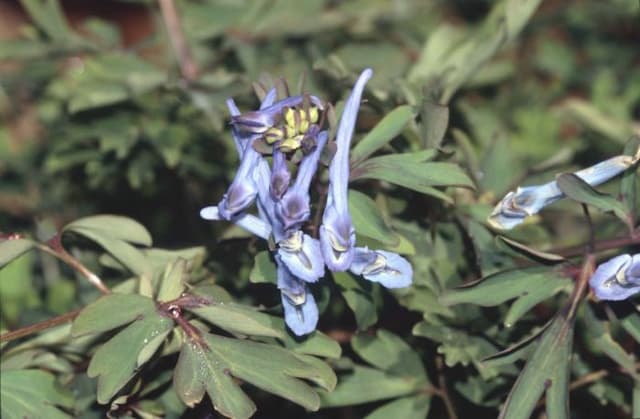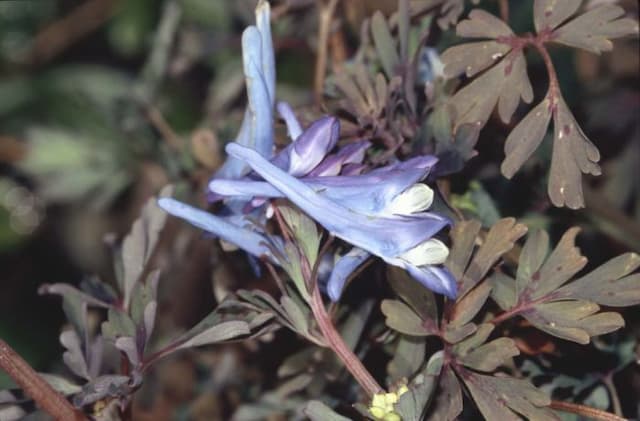Corydalis 'Blue Panda' Corydalis flexuosa 'Blue Panda'

ABOUT
'Blue Panda' is an erect, summer-dormant perennial to 30cm with highly divided leaves, blue-green sometimes flushed with purple. The slender-tubed, electric turquoise-blue flowers are produced in dense sprays from late spring to summer
About this plant
 Names
NamesFamily
Papaveraceae
Synonyms
Blue Panda Corydalis, Chinese Blue Corydalis
Common names
Corydalis flexuosa 'Blue Panda'
 Characteristics
CharacteristicsLife cycle
Perennials
Foliage type
Deciduous
Color of leaves
Green
Flower color
Blue
Height
1 foot (30 cm)
Spread
1 foot (30 cm)
Plant type
Herb
Hardiness zones
5
Native area
China
Benefits
 General Benefits
General Benefits- Attracts Pollinators: Corydalis 'Blue Panda' is known to attract bees and butterflies, which are essential for the pollination of plants and the health of the ecosystem.
- Ornamental Value: With its attractive blue flowers and fern-like foliage, it adds aesthetic appeal to gardens and landscapes.
- Shade Tolerance: This plant is well-suited for shaded areas where other plants might struggle to thrive, making it ideal for woodland gardens.
- Drought Resistance: Once established, Corydalis 'Blue Panda' can be quite drought-tolerant, reducing the need for frequent watering.
- Spring Flowering: It blooms in the spring, providing early season color when many other plants are not yet in bloom.
- Low Maintenance: This plant generally requires minimal care, making it a good choice for gardeners of all skill levels.
- Ground Cover: Its ability to spread makes it a good ground cover, which can help prevent soil erosion and suppress weed growth.
- Deer Resistance: Corydalis 'Blue Panda' is not a preferred food for deer, making it an excellent choice for gardens in areas with deer populations.
 Medical Properties
Medical Properties- This plant is not used for medical purposes
 Air-purifying Qualities
Air-purifying QualitiesThis plant is not specifically known for air purifying qualities.
 Other Uses
Other Uses- Corydalis flexuosa 'Blue Panda' can be used in informal rock gardens due to its ability to create beautiful swathes of blue when planted in clusters among rocks and stones.
- This plant can be a natural dye source, with the potential to produce shades of blue from its flowers.
- The compact size and attractive foliage of Blue Panda make it suitable for fairy gardens, where it adds a magical touch of color.
- Blue Panda may be utilized as a living mulch, covering the soil and helping retain moisture while suppressing weeds with its foliage.
- The plant can be a subtle addition to bonsai gardens, providing a different texture and flowering option compared to traditional bonsai plants.
- When used in a sensory garden, the delicate foliage and flowers of Blue Panda can offer visual interest and a soft texture to touch.
- Blue Panda is suitable for planting in grave gardens or memorial gardens where low-maintenance, shade-tolerant plants are needed.
- This Corydalis can be used in educational gardens to teach about propagation, as it can be easily divided to create new plants.
- In artistic landscape designs, Blue Panda can be used to create a naturalistic 'painting', especially in spring when its vivid blue flowers are in full display.
- Incorporated into rain gardens, Corydalis 'Blue Panda' can thrive with the fluctuating moisture levels, provided the soil remains well-drained between rains.
Interesting Facts
 Feng Shui
Feng ShuiThe Blue Panda plant is not used in Feng Shui practice.
 Zodiac Sign Compitability
Zodiac Sign CompitabilityThe Blue Panda plant is not used in astrology practice.
 Plant Symbolism
Plant Symbolism- Elusiveness: The 'Blue Panda' part of its common name and the plant's vibrant but fleeting flowers evoke a sense of something precious and hard to grasp, mirroring the elusive nature of happiness or love.
- Adaptability: Corydalis flexuosa thrives in various conditions, often in shady, rocky habitats, symbolizing the ability to adapt to diverse environments and situations.
- Tranquility: The blue color of the flowers is often associated with calmness and tranquility, making it an emblem of peace and serenity.
- Hope: The plant's propensity to bloom in early spring suggests renewal and hope, a reminder that after hardship or dormancy, life can flourish again.
 Water
WaterBlue Panda corydalis should be watered regularly to keep the soil consistently moist but not soggy. Water when the top inch of soil feels dry to the touch, which typically means once or twice a week depending on temperature and humidity. Provide enough water to soak the soil to a depth of about 6 inches. During hot, dry periods, you might need to water more frequently, while in cooler, wetter conditions, the plant may require less. Use roughly half a gallon of water per plant, ensuring it's distributed evenly around the base without splashing the foliage to avoid fungal diseases.
 Light
LightBlue Panda corydalis thrives in partial shade, preferring bright but indirect light. A spot that receives dappled sunlight or morning sun followed by afternoon shade is ideal. This plant can tolerate a few hours of direct sunlight, but it's best to avoid the intense midday sun which can scorch its leaves.
 Temperature
TemperatureBlue Panda corydalis prefers cooler conditions and is hardy in temperatures that range from about 50 to 75 degrees Fahrenheit. It can survive minimum temperatures down to about 20 degrees Fahrenheit but should be protected from harsh winter winds. The ideal temperature range for optimal growth is between 60 and 65 degrees Fahrenheit.
 Pruning
PruningPruning Blue Panda corydalis is best done to maintain its shape and remove any spent flowers to encourage new blooms. Deadheading, or cutting off the old flower stems, can be done throughout the blooming season. Cut back the plant in late fall after the first frost to prepare it for winter and promote healthy growth in the spring.
 Cleaning
CleaningAs needed
 Soil
SoilThe Blue Panda Corydalis thrives in moist, well-draining soil rich in organic matter, with a preferred pH range of 6.0 to 7.5. A mix of garden soil, leaf mold, and compost is ideal to maintain moisture while allowing excess water to drain away.
 Repotting
RepottingBlue Panda Corydalis should be repotted every 2-3 years or when the plant appears to be outgrowing its current container, to refresh the soil and allow room for growth.
 Humidity & Misting
Humidity & MistingBlue Panda Corydalis prefers a moderately humid environment; maintaining humidity levels around 50-60% is ideal for this plant.
 Suitable locations
Suitable locationsIndoor
Provide part shade, cool temps, and keep soil moist for indoor Blue Panda.
Outdoor
Plant in dappled shade, rich soil, and ensure adequate moisture outdoors.
Hardiness zone
5-9 USDA
 Life cycle
Life cycle'Blue Panda' Corydalis begins its life as a seed, which, when sown in a well-drained soil mix in early spring, will germinate and develop into a seedling. The plant grows rapidly, forming a rosette of finely divided, fern-like blue-green foliage, and by late spring to early summer, it starts to produce its distinctive blue-violet, tubular flowers. After flowering, the plant sets seed, which can be collected or allowed to self-sow. 'Blue Panda' Corydalis goes dormant in the summer, especially if conditions are hot and dry, retreating to its tuberous root until cooler, moist conditions return in the fall. During dormancy, the plant conserves energy and undergoes physiological rest. The following spring, 'Blue Panda' Corydalis resumes growth, repeating its life cycle, and sprouting new shoots from its tuberous root.
 Propogation
PropogationPropogation time
Spring to early summer
Propogation: Corydalis flexuosa 'Blue Panda', commonly known as Blue Panda Corydalis, is typically propagated by division. The ideal time to propagate this plant by division is in the spring as the plant emerges from dormancy and the new growth is just beginning to show. To propagate Blue Panda Corydalis, carefully lift the plant from the ground with a shovel, ensuring a generous amount of soil is kept around the roots to minimize disturbance. Gently tease apart the clumps of roots and shoots, making sure each division has a healthy section of roots and a few shoots. Replant the divisions at the same depth they were growing at originally, spacing them about 12 inches (approximately 30 centimeters) apart to allow for growth. Water the new divisions thoroughly to settle the soil around the roots and remove any air pockets.









